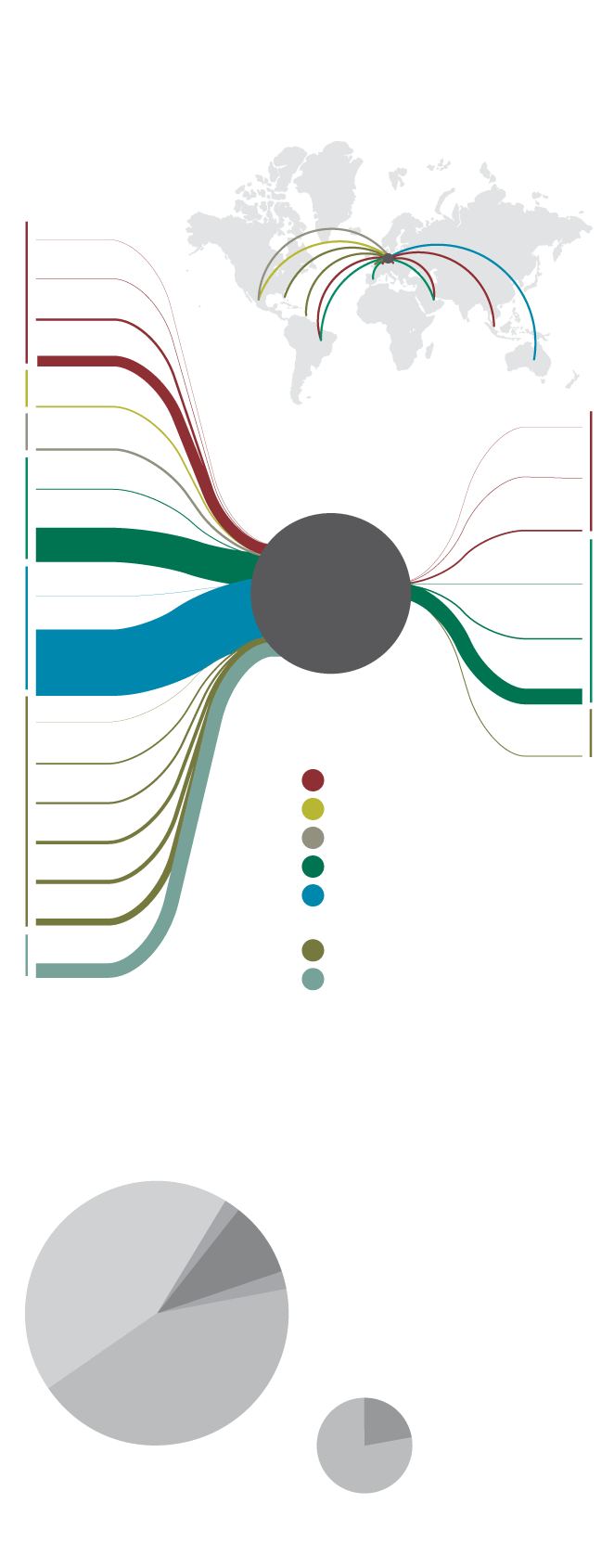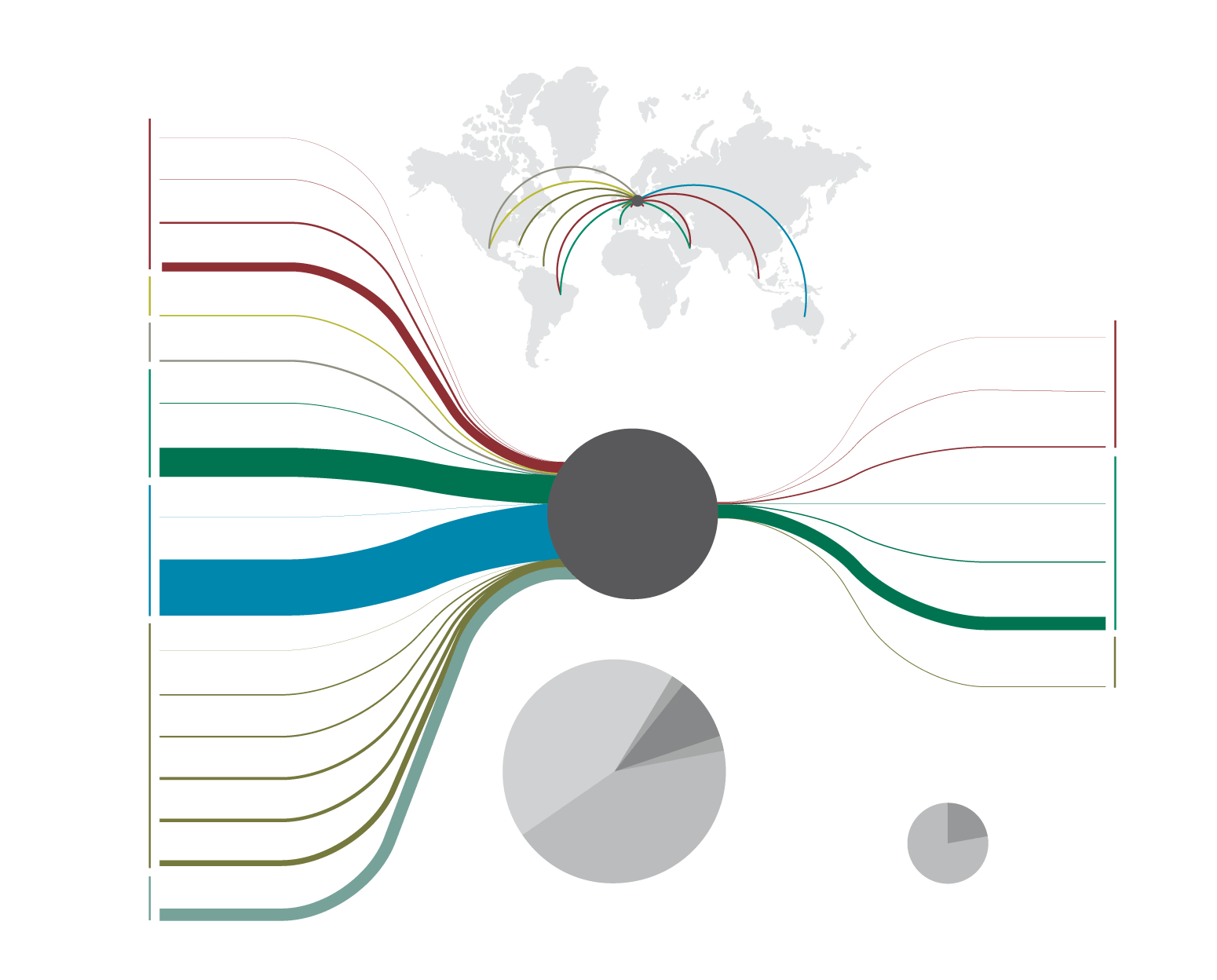For Stephen Durand, March 16, 2018, began like most other days—with an inordinate amount of squawking. Durand lives on the Caribbean island of Dominica and oversaw the federal aviary that houses rescued parrots, including casualties of Hurricane Maria. Six months earlier, the storm had leveled large numbers of the island’s trees and stripped many more of their fruit and foliage, threatening two endemic parrot species.
The festive green Red-necked Parrot, or Jaco, and the monkish, mountain-dwelling Imperial Parrot are a source of pride for Dominicans. When their populations were at an all-time low in the 1980s, Durand helped launch an amnesty program to reclaim pet parrots for research and education. After the hurricane, he hosted International Fund for Animal Welfare veterinarians who performed surgeries under generator-powered lights. “Goal is to RELEASE back home to their wild habitat!” they wrote on Twitter that February. Four Jacos were set free and aviary staff tended to those still recuperating.
In March Permanent Secretary of Agriculture Reginald Thomas sent a memo to Durand’s boss: “None of the birds being housed at the facility should be released into the wild until further notice.” Durand had an inkling of what this was about. For years he’d been concerned about a group of deep-pocketed European parrot enthusiasts cozying up to island leadership, promising to build capacity “at a local level to better manage the island’s resources,” as they wrote in a 2012 letter. Durand was skeptical. “I had been trying to avoid these people for a long time,” he says.
Led by a German named Martin Gerhard Guth, the Association for the Conservation of Threatened Parrots (ACTP) bills itself as a nonprofit dedicated to protecting endangered parrots and their habitats. Since its founding in 2006, countries, institutions, and people across the Americas have handed over rare birds to ACTP for captive breeding to rebuild populations—including Caribbean Amazons and Spix’s Macaws, which are extinct in the wild. The organization operates a licensed zoo in Germany, and birds are also kept in the personal aviaries of ACTP’s members, who pay $1,100 to join. Surplus parrots that members and zoos don’t want are traded or sold to outside breeders. One ACTP representative, for instance, sells Hyacinth Macaw chicks at his pet shop that can go for around $18,000 apiece. How many birds are bred versus collected or sold nobody knows, because ACTP does not publicly disclose its finances or structure.
When Durand left work that Friday, he told the staff he’d be attending a funeral the next day. After services, Durand got alarming news: The parrots were gone. Several Germans, accompanied by the agriculture minister, extracted the 12 healthiest specimens. The birds were flown to ACTP’s invitation-only zoo outside of Berlin—a place that so zealously guards its flock that visitors aren’t allowed to take photos without permission.
“Rare endangered parrots illegally smuggled from Dominica,” blared one headline. Both Jacos and Imperial Parrots are regulated under the Convention on International Trade in Endangered Species (CITES), but Thomas—a political appointee—approved the export permits without the sign-off from Dominican CITES authorities. Paul Reillo, president of the Florida-based Rare Species Conservatory Foundation, co-organized dozens of conservationists, including Audubon’s international director, Matthew Jeffery, to demand the parrots’ return. “There is a long history of rare Amazon parrots being taken from the Eastern Caribbean to Europe for captive breeding, with the expectation that their progeny will be released,” they wrote in an open letter. “None of these efforts have born[e] fruit.”
It’s no surprise conservationists’ hackles were raised: ACTP has been astoundingly successful at acquiring birds. In 15 years, Guth has helped his 18 breeder members obtain near-monopolies on the world’s rarest parrots. While the group says it breeds these birds for reintroduction efforts, not one offspring has ever been released into the wild and only a small fraction have ever been returned to their countries of origin. The group appears to have abandoned entirely its conservation plans in Mexico, after ACTP members got their hands on the endangered parrots they wanted there. Through ACTP, Guth and his members had effectively created a back channel for trading and breeding endangered parrots within the bounds of increasingly restrictive wildlife laws. And conservation goals, it seemed, had become an afterthought designed to put a sheen of legitimacy on the operation.
Or that’s what I deduced, because Guth wasn’t talking. I contacted him about visiting ACTP’s zoo in March 2019, but he proved flighty and mercurial. After six weeks of email exchanges, he asked me to confirm dates, then quashed the plan. “I am a [sic] easy person,” he wrote. “But your questions indicate a direction… So we stay secretive!”
Last summer, when I’d lost hope of an interview, Guth invited me for coffee at the Four Seasons in Beverly Hills, where he’d come for a wedding. A big, bald man with a brusque manner, he burst into the marble lobby and barked our drink orders in his thick German accent. Taking a seat on the patio, he asked bluntly who else I planned to interview. Guth felt like he’d been unfairly smeared before. His wasn’t the first zoo to support its activities by selling endangered animals, he pointed out. If he wanted to, he said, he could throw his parrots on a barbecue—or do anything he likes, short of personally profiting from them.
The conservation world has always had iconoclasts, some of whom succeed spectacularly. One of Guth’s efforts has, in fact, finally begun to bear fruit. This spring he made history when he sent 52 captive-born Spix’s Macaws to Brazil in preparation for their eventual release. Others had been working on this effort for three decades, but Guth was going to bring it to the finish line. And, he hoped, finally silence his critics.
Guth’s childhood memories are of an unabiding grayness. The overcast sky, the drab landscape, life itself under the Communist regime of East Germany. Born in August 1970, Guth grew up in Staaken, a town cleaved in two by the Berlin Wall. Parrots were a gaudy missive from the free world.
Guth recalled coming close enough to a caged macaw to get a whiff of its sunflower seed breath, a scent-memory that still moves him. At the age of 10, he obtained a budgie. He became infatuated with color mutants like a sickly yellow Monk Parakeet that he got from a neighbor, and later sold for 3,000 East German Ostmark, according to a blog post by a visiting breeder. That bounty, worth more than $500 today, funded cockatiels, canaries, and parakeets that Guth kept in his family’s barn.
Germans have always had a fondness for exotics. The country is home to some of Europe’s earliest zoos, and, during World War II, the Nazis exempted the Berlin Zoo from belt-tightening. When that zoo was walled off during the Cold War, East Germany built its own, which had greater attendance than the nation’s top soccer league. Today Germany has more than 400 zoos, nearly on par with the United States, which has four times the population. It also boasts both the world’s largest pet store and the world’s largest aviaries. The world’s most famous parrot park—Loro Parque in the Canary Islands with 350 species and subspecies—was founded by a German.
Guth left school in 10th grade and became an apprentice at a dairy farm, recoiling as he trimmed manure-crusted hooves. In 1989, he hopped a train to communist Hungary. From there he slipped into Austria and made his way to Hamburg in West Germany. He was trudging to a ship in the harbor that served as a floating camp for East Germans when he passed a pet store and peeked inside. The owner hired Guth as the head birdkeeper, and he performed his duties with a Red-and-green Macaw named Kojack on his shoulder.
After the wall fell that November, Guth worked in the construction business and as a nightclub bouncer, but, mostly, he ran a protection racket with a team of heavies under his command and a smoldering cigar hanging from his mouth. According to a court judgment obtained by Lisa Cox and Philip Oltermann of The Guardian, Guth warned the owner of a disco that “bad guys with chain saws and axes” could ravage the place. To another man he offered the coded threat that “wives were unprotected.” In 1992 Guth helped a drink distributor track down someone who had defrauded him. A half dozen men nabbed the culprit inside a restaurant. Guth held up his cigar cutter and threatened to cut off the man’s fingers one by one if he didn’t pay up.
Guth’s career choice eventually caught up with him. He spent two and a half years in prison in the late 1990s after being convicted of attempted fraud, predatory and attempted extortion, and hostage-taking. “I have no problems with my past,” he wrote me in April 2019. “It’s part of life.”
This frank view didn’t hold for long. Later Guth told me that, under German law, his past crimes should not have been reported by The Guardian; when I went looking for the same records at a German courthouse, they weren’t there. Guth had received a certificate of good conduct for staying out of legal trouble in the years since, he said—proof he’d moved on. But his past seemed relevant to people in parrot circles today. Many I contacted were reluctant to speak freely about him; several refused to go on record. “I promised him I won’t take his name in my mouth again,” says Robert Peters, a breeder in Bavaria who wouldn’t go into detail about his conflict with Guth. Adds another: “I underestimated his abilities and it’s one of the worst mistakes I made in my life.” And a third: “I fear for my safety and my family’s safety.”
Guth may have pure intentions when it comes to protecting parrots. And when we met, I did detect some morsel of sincerity beneath his bluster, a belief that conservation can pay for itself—and that the ends, when it comes to his beloved birds, justify the means.
Parrots are among the most threatened birds. Nearly half are declining in number, and almost one-third face extinction. Deforestation, fueled by agriculture and development, has wiped out wide swaths of their habitat. For nearly a half-century, birds have also been plucked from the wild to feed a thriving pet trade, with hundreds of thousands sold across borders at its peak.
To stem the trade, governments began enforcing existing laws and enacting new ones. The CITES permit system came into force in 1975, allowing countries to track and limit the movements of endangered animals, including parrots. In the 1980s Australia banned the export of all its native fauna for commercial purposes, and the United States and Europe enacted measures that reduced wild bird importation. Such regulations helped reduce poaching of South American parrot chicks from their nests by almost 60 percent, based on data gathered between 1979 and 1999.
Even with such measures, parrots, many of which reproduce slowly, remained dangerously depleted in the wild. Conservationists turned their attention toward captive breeding. The approach, they thought, might be key to reversing the parrots’ plight: build up populations in controlled confines, then release healthy flocks into the wild.
In the late 1970s, the Durrell Wildlife Conservation Trust launched a program with nine wild-caught St. Lucia Parrots at the Jersey Zoo in the English Channel. It hoped to produce 10 chicks per year; it hatched only 20 over the course of 20 years. Meanwhile, St. Lucia’s wild parrot population grew from perhaps 100 individuals to more than 350, thanks to habitat conservation. The lackluster results with St. Lucia Parrots aren’t unique. Back then two-thirds of captive-breeding efforts with threatened species were failing to even release birds.
Captive breeding is so expensive, slow, and risky that it’s now widely viewed as a strategy of last resort—to be used in the event of a disease, natural disaster, or another imminent threat. Thomas White works at the U.S. Fish and Wildlife Service’s Puerto Rican Parrot Recovery Program, a captive-breeding program that costs almost $1 million per year to run. He says that when done at all, captive breeding should occur within a bird’s historic range: Housing species from multiple countries in one facility can expose them to new diseases, which reintroduced birds could spread to wild populations. A successful program also needs enough birds to ensure a robust gene pool—at least two or three pairs, although 20 or more is ideal.
Even if birds are bred successfully, releasing them is always a gamble: When Loro Parque set free the first captive Spix’s Macaw in 1995, it survived about two months before flying into a power line. A review of 47 parrot-reintroduction events from the late 1970s through 2009 found that 45 percent of the time, the majority of released birds either died within a year or did not reproduce.
By the late 1990s reputable zoos emphasized their education role, funneling revenues toward field research and conservation. Jersey Zoo still touted its St. Lucia Parrots, but mostly funded in-country research. Loro Parque, whose logo features a Spix’s Macaw, spent more than $600,000 on Spix’s conservation programs in Brazil.
Private breeders still had many rare parrots, and George Amato, now head of conservation genetics at the American Museum of Natural History, wanted to preserve their genetic viability. When he contacted breeders, he got a rude awakening. “They were almost deliberately not keeping accurate records,” he says. “It’s absolutely not conservation. It’s just a distraction to the real threats to these species.”
By the turn of the century, breeders found their passion maligned by scientists and conservationists. International regulations sometimes put them at odds with the law and left them with a dwindling and often inbred supply of birds. Justifying their hobby meant propping up the old, fairy-tale version of captive breeding. But regulations had walled off the rare species they longed to propagate—at least until someone found a way to bring them together.
Fresh out of prison, Guth turned his talent for getting what he wanted to acquiring birds, a fixation he had never fully abandoned. He didn’t, at first, have any inclination to become a conservationist. He lived as a global nomad, a dealmaker who built his personal collection as his bird-hungry benefactors paid for his travel and hotel bills.
His entrée into the parrot world’s highest echelon began on July 23, 2005, when he swooped into Switzerland and bought his first three Spix’s: Ferdinand, Richie, and Beauty Queen. That year the entire breeding population amounted to 54 birds distributed among 10 or so owners and descended from seven wild individuals, likely smuggled out of Brazil. Brazil had given up on legally compelling the birds’ return, but commercial trade of the species was still forbidden. Nobody thought they’d be allowed to cross international borders.
Parrot collecting can be a competitive sport, and Guth beat out a Qatari sheikh for the trio. “The sheikh was pissed off,” says Ryan Watson, who tended the sheikh’s parrots. Guth got Germany to approve the import by vowing to cooperate with Brazil on breeding.
As word of Guth’s coup spread, Claus Utoft—the Ferrari-driving owner of a Danish clothing empire—proposed creating an association and building a German aviary. They founded ACTP in early 2006. Guth already had a good rapport with Irina Sprotte, the German official responsible for CITES permits, and later an ACTP consultant. Once birds were in Germany, they could freely move them to other E.U. countries. German authorities gave Guth contracts to care for confiscated parrots, including at least one St. Vincent Parrot. Guth scoured the world for more. At least 30 St. Vincents—the world’s largest private collection—were held in Florida by an aging clairvoyant named Ramon Noegel. Guth and Utoft bought them all. On October 17, 2006, Guth registered ACTP as a nonprofit in Florida. The next day he listed six St. Vincents on parrot4sale.com using the email address spixdeutschland@aol.com.
Guth figured it would be easy to get the birds out of Florida. But Timothy Van Norman, then the FWS permit chief, says ACTP’s initial application raised eyebrows: “If you are breeding for conservation purposes, Florida would be a more conducive climate than Germany.” Equally troubling was the sketchy provenance documentation Guth had been given on the birds, which were said to predate CITES. Guth made a personal appeal to Van Norman in Virginia, but his first application was denied. Although ACTP and St. Vincent had signed a technical partnership for parrot conservation in 2006, Guth needed a breeding agreement to make a better case for exporting the birds. He donated chickens, fertilizer, and banana plants to the agriculture ministry. He also announced his intention to build a $406,000 wildlife conservation and education center, local media reported.
St. Vincent signed the breeding agreement, despite forestry officials’ misgivings. “It’s our national symbol and should not be treated like a trading commodity,” one emailed a colleague. “ACTP presents no plans and have been asking us for a document that will show that we practically begged them to take and keep our birds,” wrote another. Nevertheless, St. Vincent shipped 16 parrots to Germany, anticipating they’d be bred with the Florida birds. Van Norman was still troubled that the agreement allowed ACTP to own some of the progeny. But his supervisor, Roddy Gabel, overruled him. “We had to trust that the other countries and people involved were operating in good faith,” Gabel says. “The Europeans in general have a more lax approach to regulating breeding facilities than we do.”
Guth continued to build his parrot war chest. He inked a breeding agreement with St. Lucia, which requested that Jersey Zoo send its five parrots to ACTP. He also found unconventional funding sources. In 2014 a German tabloid published a photo of Guth getting into a Mercedes registered to Arafat Abou-Chaker, a Berlin crime family member and past ACTP donor. (Guth has said taking the donation was a mistake, and he hasn’t been implicated in any wrongdoing.)
His most vocal nemesis was Wolfgang Kiessling, the multimillionaire collector-turned-conservationist behind Loro Parque. They were both part of the Spix’s Macaw Re-Introduction Project, a partnership of breeders, conservationists, and the Brazilian government coordinated by California-based Parrots International, created with an aim of reintroducing the birds to the wild.
Loro Parque’s Spix’s legally belonged to Brazil. Kiessling signed over ownership during an earlier Spix’s partnership in the 1990s, hoping other collectors would follow. None did. Nor did the partners permit Kiessling to buy a Spix’s pair for exhibition, which would generate income to further fund efforts in Brazil—efforts Kiessling had already bankrolled. No Spix’s were on display at the time, and the view was the precious individuals should be reserved for breeding.
Kiessling was displeased when Guth purchased his first three Spix’s, making them a commercial object once again and disregarding a pact breeders had made. Shortly after, Guth told the consortium he’d purchased 12 more in Switzerland; he refused to share DNA samples, leading those birds to be ejected from the breeding program in 2008. The two men butted heads until Kiessling finally left the group. That’s when his magnanimous giveaway to the Brazilians came back to bite him. Brazil asked Loro Parque to send them four birds and Guth two others. Guth has since sent Spix’s to be displayed at zoos in Singapore and Belgium in exchange for funding. Times had changed as Spix’s numbers had grown. But not soon enough for Loro Parque, which never exhibited its prized species. Kiessling clung to his last ailing bird until her death in 2014. He didn’t even respond when Brazil requested the carcass.
Four months after I met Guth, he invited me to ACTP’s $3.8 million zoo in Berlin. He picked me up at the airport in his BMW. Over dinner, he grumpily waved away my recorder and expressed annoyance at every question. The next morning, before visiting the zoo, he gave me a contract stipulating that I couldn’t quote ACTP employees or share photos without the board’s written approval. We wrangled over the wording and its meaning for hours. When he implied I could still quote him, I signed—a miscalculation that ultimately led to drawn-out negotiations over fact-checking and a cease-and-desist letter. The photographer, too, was sent a cease-and-desist letter and told that Guth had withdrawn consent for photography. Nervous about a lawsuit, and her personal safety, she asked Audubon not to publish her photos. I’ve chosen not to quote Guth from my interviews, to avoid any possibility of violating the contract or journalistic ethics.
But before all that, before the escalating legal actions, Guth took me and the photographer around the zoo. He seemed, finally, at ease. Bundled up in winter clothes, we walked around cages organized by geography—Australia, the Caribbean, and South America—and decorated with colorful murals depicting the birds’ native habitats. The facility struck me as impeccable. Pampered birds drink only bottled mineral water. Technicians weigh meals to the milligram.
Inside a nursery, Guth and I watched a technician pour organic oats into a bowl. With gloved hands, she retrieved a Spix’s chick from an incubator and placed it atop the bed of grain to weigh it. A baby parrot is a homely creature with pink, wrinkly flesh, but I saw Guth’s hard expression soften when this one came into view. The staffer squirted a warm syringe of food into its open beak, and it jackhammered its head to force down the gruel.
Most of the 150 Spix’s at ACTP that day—some 90 percent of the global population—were originally bred in Qatar. Guth’s one-time competitor, Sheikh Saud Bin Mohammed Bin Ali Al-Thani, reportedly injected millions into that effort, including developing an artificial-insemination program, and then ran out of cash. Three years after his untimely death, in 2014, ACTP expanded its aviaries and was loaned all of his Spix’s and Lear’s Macaws for five years. “The best thing that happened to the Spix’s Macaws was the sheikh dying,” says Watson. He doubts the sheikh would have returned the birds to Brazil and has come to respect Guth’s devotion to his mission.
Guth also impressed Mark Stafford, founder of Parrots International, when, in 2006, he helped pay for a farm with the last known Spix’s breeding site. For years Guth remained reserved as the newcomer at meetings for the reintroduction project. But by 2015 Kiessling was out and the sheikh was dead and Guth had lost patience with the experts’ yammering. At a meeting in Campo Grande, he told everyone to leave the room except those who had cash to carry out their plans. “Martin is a no-bullshit kind of guy,” says Stafford. “He can be nice and he can be”—he paused—“not nice, I guess.”
The reintroduction site consists of a large protected area of Caatinga forest that allows ranching but is off-limits to development. Spix’s are dependent on riparian corridors, where they nest in tree cavities. With habitat secured, Brazilian NGOs and wildlife authorities are planning how to ease the eventual return, such as by controlling beehives in tree cavities. Determined to avoid the fate of the first failed reintroduction, the Brazilians “have done quite a bit to help improve the chances of success,” says FWS’s White, a project consultant.
At the core of the protected area sits 6,000 acres of privately owned land, where ACTP is building breeding and reintroduction facilities. Its role in Brazil is limited to managing birds there until their release, which will be staggered over the next five years. Cromwell Purchase, who led Sheikh Saud’s Spix’s program and is ACTP’s scientific director, has moved to Brazil to work on the first test releases, expected this year. Guth aims to keep approximately 30 Spix’s pairs in Berlin, as breeders must ship 70 percent of chicks to Brazil each year. That mandate, combined with ACTP’s delivery of 52 Spix’s to Brazil in March, leaves Guth with empty cages to fill.

Birds Sent to ACTP vs. Birds Leaving ACTP
Source country/
(number of birds)
Czech Republic (1)
Brazil (2)
Germany (8)
Qatar (37)
Mexico (6)
Czech Republic (1)
Mexico (8)
Singapore (2)
Spain (3)
Qatar (120)
Belgium (6)
Association for
Singapore (2)
the Conservation
Germany (1)
of Threatened
Australia (232)
Parrots (ACTP)
Belgium (5)
Brazil (55)
Germany (1)
St.
Vincent (3)
Species
St. Lucia (6)
Jersey Island,
UK (7)
Lear’s Macaw
Maroon-fronted Parrot
Thick-billed Parrot
Spix’s Macaw
Cockatoos, lorikeets, and other parrots
Caribbean parrots
Additional species
Dominica (12)
St. Vincent (15)
Florida (24)
Multiple (51)
Source of birds sent to ACTP vs. destination of birds leaving ACTP
Source
Foreign collectors (232)
Foreign zoos (10)
Range country (49)
European confiscation (11)
Australian breeders (232)
Destination
Foreign zoos (16)
Repatriated (56)

Birds Sent to ACTP
Species
Source country (number of birds)
Lear’s
Czech Republic (1)
Macaw
Brazil (2)
Germany (8)
Birds Leaving ACTP
Qatar (37)
Maroon-fronted
Parrot
Destination
Species
Mexico (6)
Lear’s
Czech Republic (1)
Thick-billed
Macaw
Parrot
Mexico (8)
Singapore (2)
Spix’s
Spain (3)
Macaw
Belgium (6)
Qatar (120)
Spix’s
Association for
Macaw
Singapore (2)
Cockatoos,
Germany (1)
the Conservation
lorikeets, and
of Threatened
other parrots
Australia (232)
Parrots (ACTP)
Belgium (5)
Brazil (55)
Caribbean
Germany (1)
Foreign collectors (232)
parrots
Carribean
St. Vincent (3)
Foreign zoos (10)
parrots
St. Lucia (6)
Range country (49)
(7)
Jersey Island, UK
European confiscation (11)
Dominica (12)
Australian breeders (232)
St. Vincent (15)
Foreign zoos (16)
Florida (24)
Repatriated (56)
Multiple (51)
Additional
Source of birds
Destination of birds
species
sent to ACTP
leaving ACTP
In an export application, ACTP once wrote that it “will develop and apply novel methods for the funding of parrot conservation under the principle of ‘Can Wildlife Pay for Itself.’ ” ACTP certainly seems to have fine-tuned a model in which parrot breeding funds its operation. In 2014 Germany granted it a zoo license, giving it a tax exemption, among other benefits. Thanks to that newfound status, it could also take advantage of a loophole in Australia’s export ban that allows exports for exhibition purposes. ACTP has since obtained more than 200 parrots from Australia. Guth and his members are breeding them in Europe, though most have odd color mutations, making them valuable only for the allure and cash flow they potentially generate.
Whether or not ACTP will meaningfully advance parrot conservation, especially for the breathtaking range of species it has acquired, remains an open question. Nine years after its breeding agreement with St. Vincent, the wildlife center hasn’t been built, and Guth just repatriated the first three chicks in November. St. Vincent’s forestry head was unaware that ACTP has hatched 10 chicks since 2016. St. Lucia, meanwhile, has gone all-in, plucking wild chicks from nests for ACTP’s breeding program. ACTP, in turn, has reportedly provided $2.5 million to revamp a zoo there.
As for Dominica, Durand says he was asked to take temporary leave for speaking out against ACTP, and in-country parrot work has ground to a halt. “They have almost demolished our conservation program,” he says. “That is what ACTP has done.”
On my second morning in Berlin, Guth led me to the two Imperials shipped from Dominica. We saw the male immediately, a dark form at the far end of the cage. When he spotted us, he slipped into the heated back room, where Guth said his much older mate was huddled. Fewer than 50 Imperials likely remain in the wild. Females probably take 10 years to reach sexual maturity and typically lay one egg per year, making a self-sustaining population a farfetched undertaking.
ACTP has said Dominica, worried about more storms like Maria, instigated the transfer of its parrots. The 10 Jacos brought over had already produced two chicks. The Imperials, none. When I asked Guth what he could achieve with just two, he reminded me that ACTP began with three Spix’s.
I knew by now a plan was likely already taking shape. Reillo, who led the call for the Jacos’ return, isn’t only one of Guth’s fiercest opponents. He also tends to the only other known captive Imperial Parrot, evacuated due to an emergency in 2010. At the 2018 CITES meeting in Germany, Guth or his people are rumored to have approached U.S. officials about exporting the Imperial in Reillo’s care to Germany. It could only happen with Dominica’s endorsement, of course.
This story originally ran in the Summer 2020 issue. To receive our print magazine, become a member by making a donation today.



